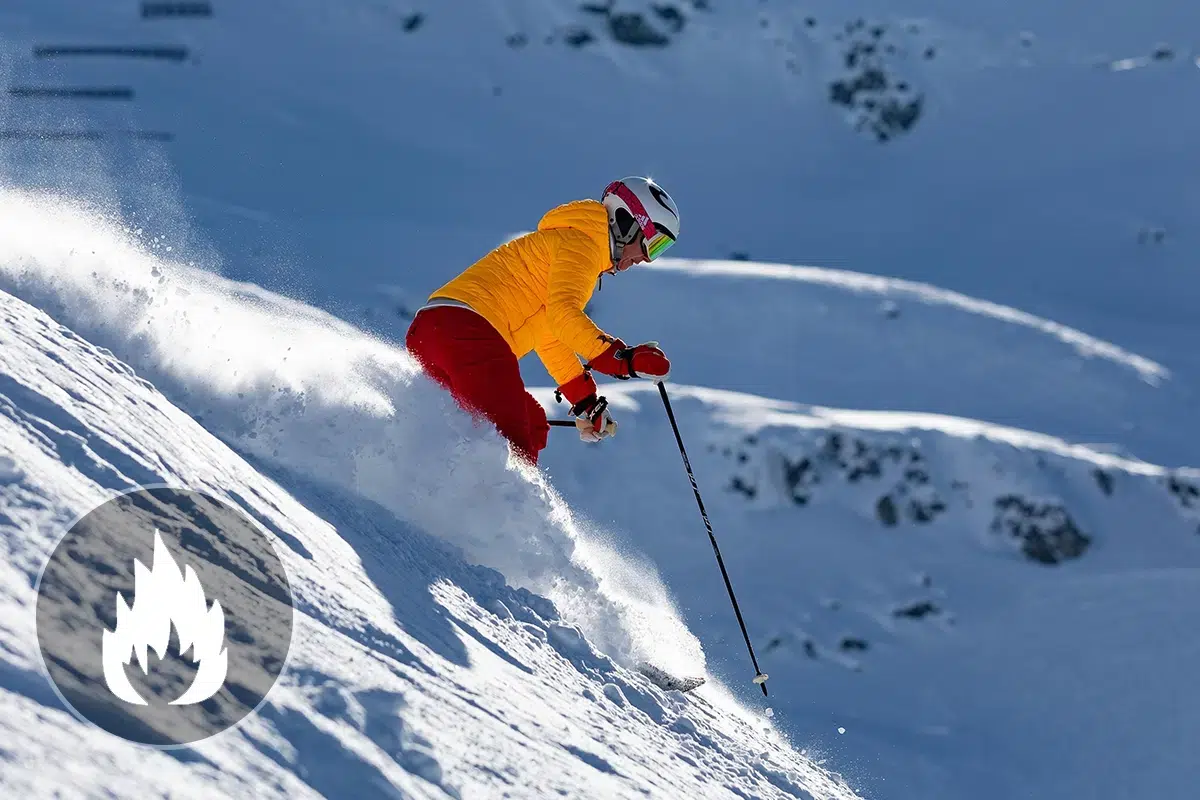Show summary Hide summary
How many calories do you burn skiing downhill?

All you need to know about downhill skiing
🎿 Want to know how many calories you burn in 30 minutes, 1 hour or a full day of skiing? Just enter your skiing time and profile (age, weight, height) to see your calorie expenditure.
Alpine skiing or downhill skiing: A few examples of energy expenditure depending on weight and activity time.
Use the table below to see how many calories you lose skiing downhill in the resorts!
Downhill skiing
Light intensity
Kilocalorie expenditure
| Weight | 15 minutes | 30 minutes | 1 hour |
|---|---|---|---|
| 40 kg | 53 | 105 | 210 |
| 50 kg | 66 | 131 | 263 |
| 60 kg | 79 | 158 | 315 |
| 70 kg | 92 | 184 | 368 |
| 80 kg | 105 | 210 | 420 |
| 90 kg | 118 | 236 | 473 |
Downhill skiing
Moderate intensity
Kilocalorie expenditure
| Weight | 15 minutes | 30 minutes | 1 hour |
|---|---|---|---|
| 40 kg | 63 | 126 | 252 |
| 50 kg | 79 | 158 | 315 |
| 60 kg | 95 | 189 | 378 |
| 70 kg | 110 | 221 | 441 |
| 80 kg | 126 | 252 | 504 |
| 90 kg | 142 | 284 | 567 |
Downhill skiing
High intensity
Kilocalorie expenditure
| Weight | 15 minutes | 30 minutes | 1 hour |
|---|---|---|---|
| 40 kg | 84 | 168 | 336 |
| 50 kg | 105 | 210 | 420 |
| 60 kg | 126 | 252 | 504 |
| 70 kg | 147 | 294 | 588 |
| 80 kg | 168 | 336 | 672 |
| 90 kg | 189 | 378 | 756 |
See detailed calculations and metabolic equivalent for alpine skiing
All you need to know about downhill skiing
FIND OUT MORE ABOUT DOWNHILL SKIING
Alpine skiing, also known as downhill skiing, allows you to hurtle down the slopes. Poles help skiers to make the turns (who hasn’t seen the famous pole planting in Les bronzés font du ski).
Although it will take years for this sport to gain Olympic credentials, it would be inconceivable to do without it today, such is the spectacular nature of the sport.
Alpine skiing includes the following disciplines:
- Downhill
- Slalom
- Giant slalom
- Super-G
- Combined
- Freestyle
Alpine skiing is a popular winter sport that involves skiing down snow-covered slopes. It’s an exciting and stimulating activity that offers many physical and mental benefits. Whether you’re a beginner or an experienced skier, downhill skiing can be an exciting experience in the snowy mountains.
Some benefits of doing alpine skiing or downhill skiing:
- Muscle strengthening: Downhill skiing uses many muscles in the body, including the legs, thighs, buttocks, abdominal muscles and upper body muscles. Descending the slopes, turning and controlling the skis all help to strengthen the muscles and tone the body.
- Improving balance and coordination: Alpine skiing requires good balance and precise coordination to control the skis in different situations, such as turns and jumps. This can improve proprioception, core stability and overall body coordination.
- Improved stamina and fitness: Alpine skiing is a physical activity that stimulates the cardiovascular system, improving stamina and overall fitness. Climbing the slopes, gliding down the slopes and repeating descents all contribute to improving cardiorespiratory capacity.
- Mental stimulation: Alpine skiing requires mental concentration and quick decision-making to navigate the slopes, assess snow conditions and anticipate obstacles. This can stimulate cognitive function, mental reactivity and problem-solving skills.
- Connection with nature: Alpine skiing is generally practised in magnificent natural environments, surrounded by snow-capped mountains. This offers an immersive experience in the middle of nature, promoting relaxation, connection with the environment and an overall sense of well-being.
- Fun and entertainment: Alpine skiing is first and foremost a recreational activity that provides fun and entertainment. The sensation of sliding, the speed, the dizzying descents and the pleasure of sharing these moments with friends and family make downhill skiing a unique and memorable experience.
Whether you’re a thrill-seeker or simply looking to enjoy the beauty of snow-capped mountains, downhill skiing offers many physical, mental and emotional benefits. Remember to wear the right ski equipment, including a helmet and warm clothing, and to follow the safety rules on the slopes to make the most of this winter experience.
How to calculate the number of calories burned doing downhill skiing
The result displayed is expressed in Kcal and is calculated using the MET (Metabolic Equivalent of Task). The MET for each activity is the result of statistical data and cannot therefore be interpreted as an exact calculation, but rather as an estimate that takes into account the MET value and the ratio between the time spent doing an activity and the weight of the individual.
For example: The MET value for downhill skiing is 6 in moderate. This means that a person doing moderate downhill skiing consumes 6 times more energy than when resting during a day’s skiing.
MET values for the different levels of downhill skiing intensity
- Low-intensity downhill skiing: MET = 5
- Moderate-intensity downhill skiing: MET = 6
- High-intensity downhill skiing: MET = 8
Discover the detailed formula to calculate your daily energy expenditure while doing downhill skiing
Consumption in Kcal per minute = (METs*3.5*Weight in kilos)/200
This gives for a person weighing 70 kilos for 30 minutes:
Consumption in Kcal per minute = (6*3.5*70)/200 = 7.35 Kcal/mn
So for 30 minutes = 7.35*30 = 220.5 kcal for 30 minutes
All sports in detail!



















































